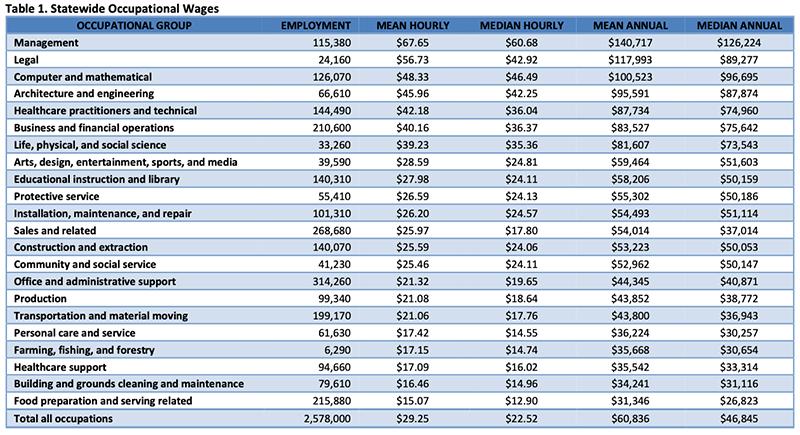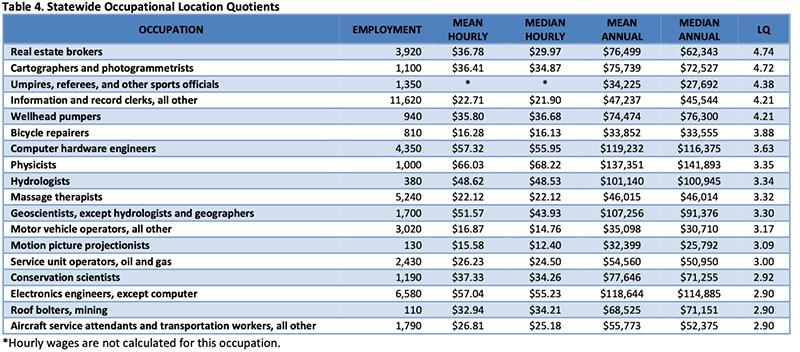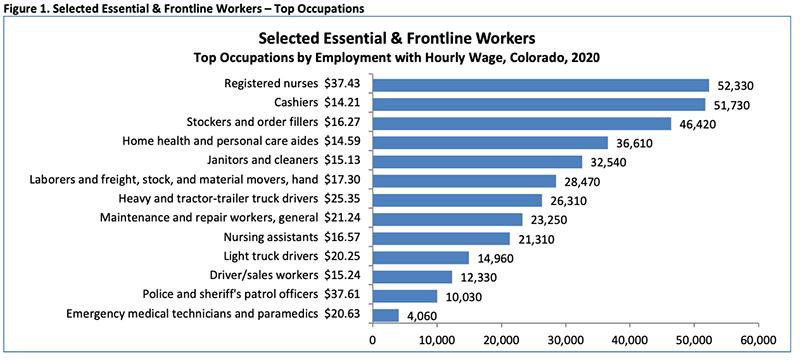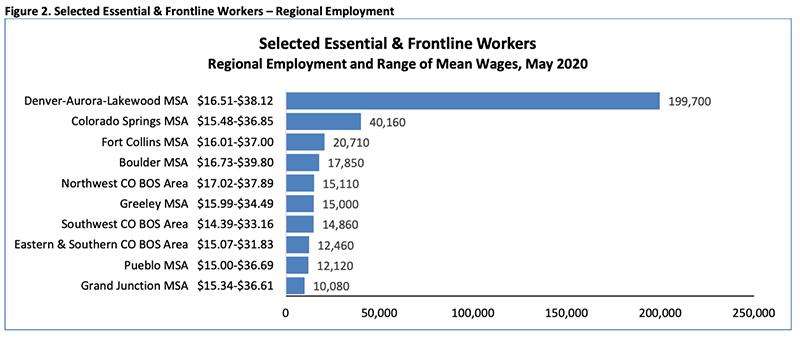For Immediate Release
Date: April 5, 2021 / 8:00 A.M.
Contact: Office of Government, Policy and Public Relations
Email: cdle_pr@state.co.us
Web: http://www.colmigateway.com
Colorado Occupational Employment and Wages — 2020
| The Occupational Employment and Wage Statistics (OEWS)1 program is a Federal-State cooperative program that provides estimates of employment and wages for over 800 non-military detailed occupations in 22 major occupational groups. Every year, the Colorado Department of Labor and Employment, in partnership with the Bureau of Labor Statistics, collects and publishes occupation and wage data for the State of Colorado and for ten substate regions: seven Metropolitan Statistical Areas (MSAs) and three Balance of State (BOS) Areas. |
Statewide Highlights
Workers in the State of Colorado had an average (mean) hourly wage of $29.25 in 2020, about 8 percent above the US average of $27.07, according to the Colorado Department of Labor and Employment and the US Bureau of Labor Statistics. The statewide median hourly wage2 for all covered employment3 was $22.52 compared to the US median of $20.17.
Statewide Occupational Employment and Wages
The occupational groups with the most workers were office and administrative support (314,260 workers), sales and related (268,680), and food preparation and serving related occupations (215,880). These three groups accounted for 31 percent of total covered employment. Management occupations had the highest average wage, while food preparation and serving related occupations had the lowest (see Table 1).
Regional Occupational Employment
The most common detailed occupations statewide were retail salespersons (70,060 workers), fast food and counter workers (64,720), and project management specialists and business operations specialists, all other (53,490), and these were also the top three occupations in most of the substate areas (see Table 2).
Regional Occupational Wages
The Boulder MSA had the highest overall average and median wages and the Eastern & Southern Colorado BOS Area had the lowest (see Table 3). Both Boulder and Denver had average and median wages that are higher than the statewide average and median.
Statewide Location Quotients
A location quotient (LQ) allows us to explore the occupational make-up of a state, MSA, or BOS Area by comparing the composition of jobs in an area relative to the national average. For example, an LQ of 2.0 indicates that an occupation accounts for twice the share of employment in an area than it does nationally.
Compared to the US, Colorado demonstrated a higher share of employment in computer and mathematical (LQ of 1.48), architecture and engineering (1.43), life, physical, and social science (1.38), business and financial operations (1.35), and construction and extraction (1.27) occupations and a lower share of employment in production (0.63), farming, fishing, and forestry (0.71), management (0.78), and healthcare support (0.79) occupations. See Table 4 for detailed occupations with the highest LQs.
Regional Location Quotients
The occupations with the highest concentrations of employment in each substate area were physicists in the Boulder MSA (LQ 42.24), religious workers, all other in the Colorado Springs MSA (10.01), cartographers and photogrammetrists in the Denver-Aurora-Lakewood MSA (6.38), conservation scientists in the Fort Collins MSA (24.93), roustabouts in the Grand Junction MSA (16.84), wellhead pumpers in the Greeley MSA (42.75), commercial pilots in the Pueblo MSA (7.02), graders and sorters, agricultural products in the Eastern & Southern Colorado BOS Area (38.15), roof bolters, mining in the Southwest Colorado BOS Area (60.85), and forest and conservation technicians in the Northwest Colorado BOS Area (10.88).
Spotlight on: Selected Essential & Frontline Workers
Representative occupations for essential and frontline workers were derived from publications of the Bureau of Labor Statistics (www.bls.gov/careeroutlook/2020/article/essential-work.htm) and the Brookings Institution. A total of 360,350 workers were employed in these occupations statewide, accounting for 14 percent of total employment. See Figures 1 and 2 and Table 5 for more information on essential and frontline workers.
The Colorado Occupational Employment and Wage Statistics Survey
In Colorado, 3,635 businesses were initially surveyed beginning in November of 2019 and 3,673 were initially surveyed beginning in May of 2020. After excluding establishments that were out of business or out of scope, a total of 81.1 percent of 6,833 businesses provided information on the job titles and wages of their employees. These data were combined with responses from the previous two years (four biannual surveys) to produce the 2020 occupational estimates highlighted in this document.
OEWS data are available from BLS at www.bls.gov/oes/tables.htm and on the CDLE LMI website at www.colmigateway.com (Products & Resources: Data OR Data Trends > Employment and Wage Data > Occupation Data: LMI Gateway Related Items). Industry-specific data (NAICS Sector and 3- and 4-digit, Excel files) are available at www.bls.gov/oes/current/oes_research_estimates.htm.
1Occupational Employment and Wage Statistics (OEWS) Name Change – The Occupational Employment Statistics (OES) program has changed its name to Occupational Employment and Wage Statistics (OEWS) to better reflect the range of data available from the program. Data released on or after March 31, 2021, will reflect the new program name. Webpages, publications, and other materials associated with previous data
releases will retain the Occupational Employment Statistics name.
2The median wage (50th percentile wage) is the point at which one-half of workers make less than the amount and one-half make more.
3Employment covered by state unemployment insurance laws or, for federal workers, covered by the Unemployment Compensation for Federal Employees program.
Technical Notes
The OEWS survey is a semiannual survey measuring occupational employment and wage rates for wage and salary workers in nonfarm establishments in the United States. The OEWS data available from BLS include:
- cross-industry occupational employment and wage estimates for the nation and for over 580 areas, including
- states and the District of Columbia, MSAs, nonmetropolitan areas, and territories;
- national industry-specific estimates at the NAICS sector, 3-, 4-, and selected 5- and 6-digit industry levels; and
- national estimates by ownership across all industries and for schools and hospitals.
OEWS data are available at www.bls.gov/oes/tables.htm.
OEWS estimates are constructed from a sample of about 1.1 million establishments. Each year, two semiannual panels of approximately 180,000 to 185,000 sampled establishments are contacted, one panel in May and the other in November. Responses are obtained by mail, Internet or other electronic means, email, telephone, or personal visit. The May 2020 estimates are based on responses from six semiannual panels collected over a 3-year period: May 2020, November 2019, May 2019, November 2018, May 2018, and November 2017. The overall national response rate for the six panels, based on the 50 states and the District of Columbia, is 69 percent based on establishments and 66 percent based on weighted sampled employment. The unweighted sampled employment of 83 million across all six semiannual panels represents approximately 56 percent of total national employment. For more information about OEWS concepts and methodology, go to www.bls.gov/oes/current/oes_tec.htm
The May 2020 OEWS estimates are the second set of OEWS estimates to be based in part on survey data collected using the 2018 SOC. These estimates use a hybrid of the 2010 and 2018 SOC systems. For more information on the hybrid classification system used in the May 2020 OEWS estimates, please see the “Changes and special procedures in the May 2020 estimates” section at www.bls.gov/oes/current/oes_tec.htm. Information about the SOC system is available on the BLS website at www.bls.gov/soc and information about the NAICS system is available at www.bls.gov/bls/naics.htm.
Substate area definitions
The substate area data published in this release reflect the standards and definitions established by the US Office of Management and Budget.
Additional information
Answers to frequently asked questions about OEWS, including uses of OEWS data, are available at www.bls.gov/oes/oes_ques.htm.
###






